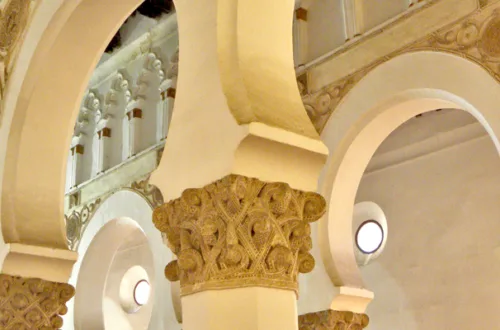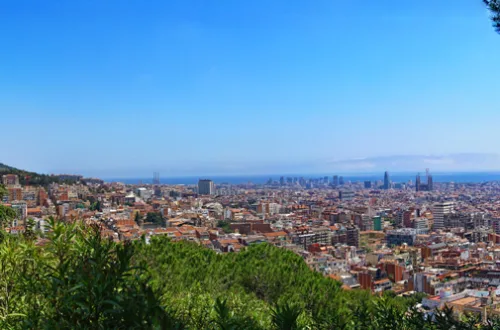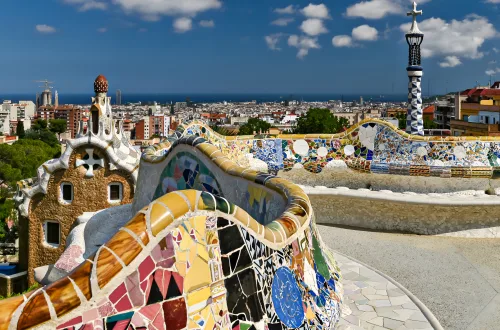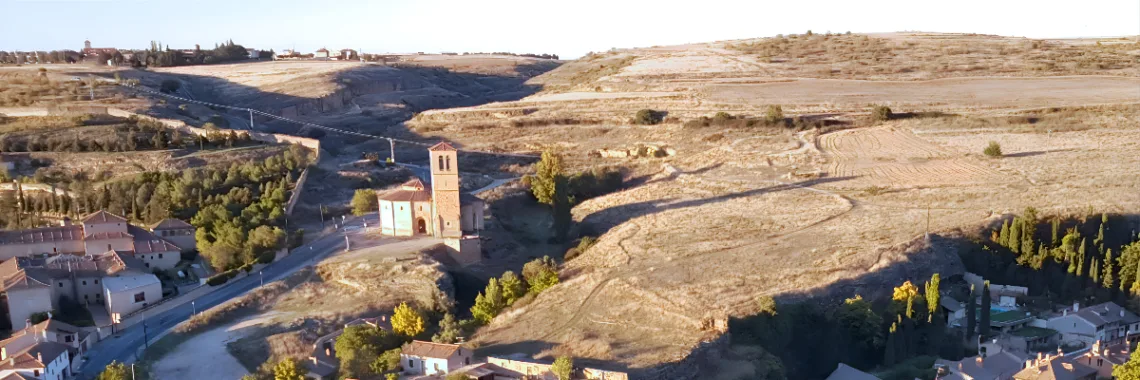
The Church of Vera Cruz: a mysterious place in Segovia legends tie to the Knights Templar and their secret knowledge of the “true cross”
The mysterious Church of Vera Cruz is a historical structure in Segovia (Spain) that has captured the hearts of visitors for centuries. Its origins are shrouded in myth and uncertainty. Some claim the Knights of the Order of the Temple founded it. Others invoke the Order of the Holy Sepulcher from Zamora.
Regardless of its indefinite beginnings, the church has been a place of pilgrimage for centuries. It was once known for a reliquary containing a piece of the Lignum Crucis (the cross where Jesus Christ supposedly died on). That is where its name comes from: “vera cruz” literally means “true cross”.
Today, the temple stands out as a popular destination for tourists, with its impressive structure, intricate carvings, and beautiful stained-glass windows. However, its real magic lies somewhat hidden from the public gaze, concealed in captivating legends and mysterious past.
So, join me on a journey to the Church of Vera Cruz in Segovia. A magnificent temple steeped in medieval tales that beckons us to step inside its walls and discover what it veiled for so many years.
- The History and location of the Church of Vera Cruz in Segovia
- Architecture and Art of the Church of Vera Cruz in Segovia
- The exterior of the church
- The tower of the Church of Vera Cruz in Segovia
- The interior of a mysterious temple
- The central Aedicula of the Church of Vera Cruz in Segovia
- The apses of the Church of Vera Cruz in Segovia
- The Lignum Crucis Chapel of the Church of Vera Cruz in Segovia
- The artwork and imagery found within the Church of Vera Cruz in Segovia
- The Altarpiece of the Resurrection, a masterwork in Church of Vera Cruz
- Symbolism and Legends of the Church of Vera Cruz in Segovia
- Celebrations and Rites in the Church of Vera Cruz in Segovia
- Visiting the Church of Vera Cruz in Segovia
“It is only with the heart that one can see rightly; what is essential is invisible to the eye.”
Antoine de Saint-Exupery
The History and location of the Church of Vera Cruz in Segovia
The Church of Vera Cruz in Segovia has a rich and intriguing history. Initially built in 1208 as the parish church of Zamarramala, this Romanesque structure has been credited to the Knights of the Order of the Temple for centuries. As legend has it, they chose this location outside Segovia due to its mysterious, untold force.
This was likely based on a letter Pope Honorius III sent them on May 13, 1224, along with a relic of the Lignum Crucis (the cross where Jesus Christ supposedly died). However, several historians refuted this claim. They concluded the church was founded in 1208 by the Order of the Holy Sepulcher, as an “Encomienda” of its collegiate of el Toro, in Zamora.

Three centuries later (on September 23, 1531), the church went to the hands of the Order of St. John of Jerusalem. Moreover, its title passed to the Church of Santa Maria Magdalena, in Zamarramala, in 1692. And so, the temple received the new denomination of “Our Lady of Peace”. Although today, everyone still knows it as the Church of “Vera Cruz”….
At the beginning of the 20th century, the temple was in a state of ruin. So much so that people even used it to store livestock. However, in 1919, the City Council took over and declared it a Historical-Artistic Monument.
After the Spanish Civil War (1936-1939), the Church of Vera Cruz in Segovia was restored by architect Francisco Javier Cabello Dodero. On May 11, 1949, the Ministry of National Education ceded it to the Order of Malta. They took possession on May 31, 1951, and remained there ever since.
Architecture and Art of the Church of Vera Cruz in Segovia
Segovia’s Church of Vera Cruz is not only a place of rich history, but also of unique architectural design. It features a distinctive centralized plant that sets it apart from other religious structures. It also imbues it with rich symbolism, and links it to the Holy Sepulcher of Jerusalem.
Often mistaken for an octagonal building, typical of the Temple Order, the church boasts twelve sides. Four of them have attached cylindrical apses, a cylindrical sacristy, and a square tower.
Nevertheless, the Church of Vera Cruz in Segovia remains a peculiar construction for the Europe of its time. Why would someone bother to construct so many sides for a relatively small building?
The more probable explanation refers to symbolic meaning. An octagon was a middle ground between the earth (represented as a square) and heaven (defined as a circle or a dome). Following this strain of thought, the more sides a polygon has, the further it moves away from the square (earth) and the closer it gets to the circle (heaven).
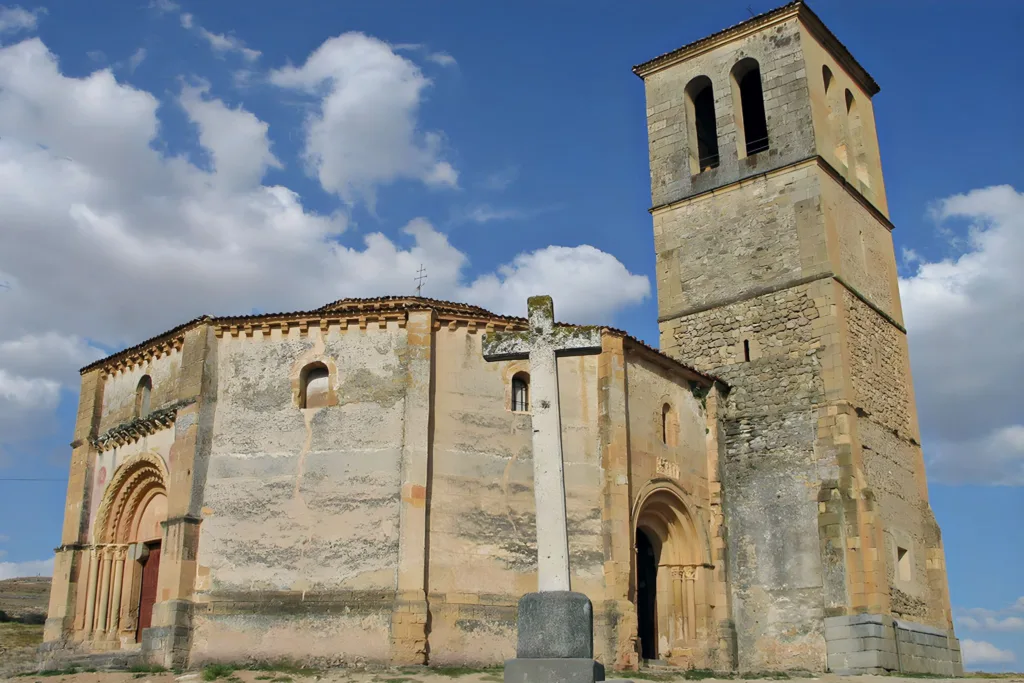

Therefore, with its twelve sides, the Church of Vera Cruz symbolizes its very spiritual nature and closeness to the afterlife. In fact, in the Book of Revelation, the “New Jerusalem” (heaven) was a circular city with twelve gates.
Furthermore, the number 12 holds great significance in Judeo-Christian tradition. It symbolizes the 12 apostles, the 12 tribes of Israel, the 12 gates of Jerusalem, the 12 zodiac signs, and the 12 months of the year.
This reference to 12 adds to the church’s historical and spiritual significance, connecting it to central religious themes and medieval motifs. It also adds to its allure and mystique, making it a remarkable destination for tourists and pilgrims alike.
The exterior of the church
The church of Vera Cruz is a unique gem of Spanish Romanesque architecture located outside the walls of Segovia. With its austere exterior and limited figurative decoration, it stands out as an atypical example of its genre.
The exterior showcases whitewashed masonry, except for its central body, columns, arches, and windows, all carved in stone. Its circular floor plan resembles the Holy Sepulcher in Jerusalem. Furthermore, its twelve sides make up two bodies topped by a pyramidal lantern.
The church grants access through two simple portals, one to the south and one to the west.
The main entrance to the Church of Vera Cruz in Segovia
The main entrance emerges from a semicircular horseshoe-shaped arch supported by six columns, three on each side. These columns feature intricate carvings and biblical motifs. These include David and Goliath with a lion, the Holy Trinity, demons binding a sinner, and elaborate floral patterns.
The tympanum, a triangular pediment above the arch, rests over two granite corbels and is framed by a lintel arch. It showcases a red patriarchal cross, similar to the one from the Holy Relic of the True Cross. And also, two painted crosses of Malta.
The entrance is topped with a cornice embellished with flowers and vegetation, while the eaves feature unique carved decorations, including a deer, a serpent, and birds.

The side entrance
The side entrance of the church is simpler than the main one. The door features two plain and unadorned arches supported by four columns, each with its own unique capital. One features harpies, another, the Annunciation of the Virgin (over an architectural background), and the other two, floral motifs.
Although this entrance doesn’t have a tympanum like the main one, an intricate relief still presides above the door. It depicts the Three Marys visiting the empty tomb of Christ, while accompanied by an angel.
It is also noteworthy that this entrance was once covered by a porch that offered shelter to worshipers. However, it unfortunately vanished without a trace.
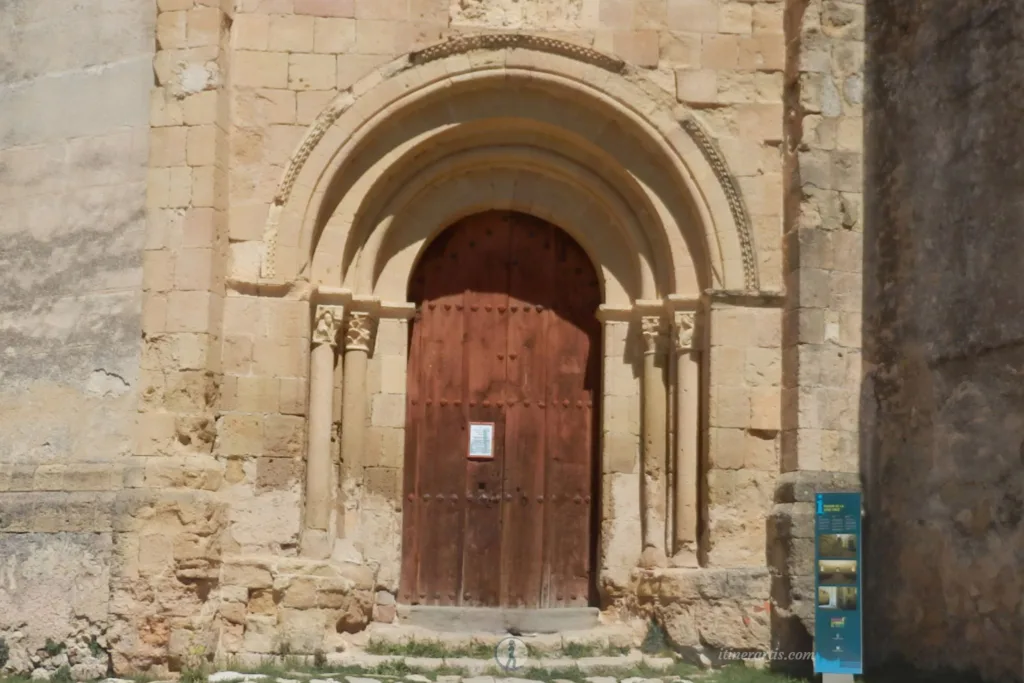
The tower of the Church of Vera Cruz in Segovia
The tower of the temple, built with four levels, rises tall on the right side of the entrance door. The first two levels and a portion of the third are original structures. The top is more modern, dating from the 16th century.
Moreover, small external buttresses reinforce the lower levels, while the top features open arches on either side.
A spiral staircase once led up to the bells. But today, the tower houses the Chapel of the Lignum Crucis, which we’ll discuss later.
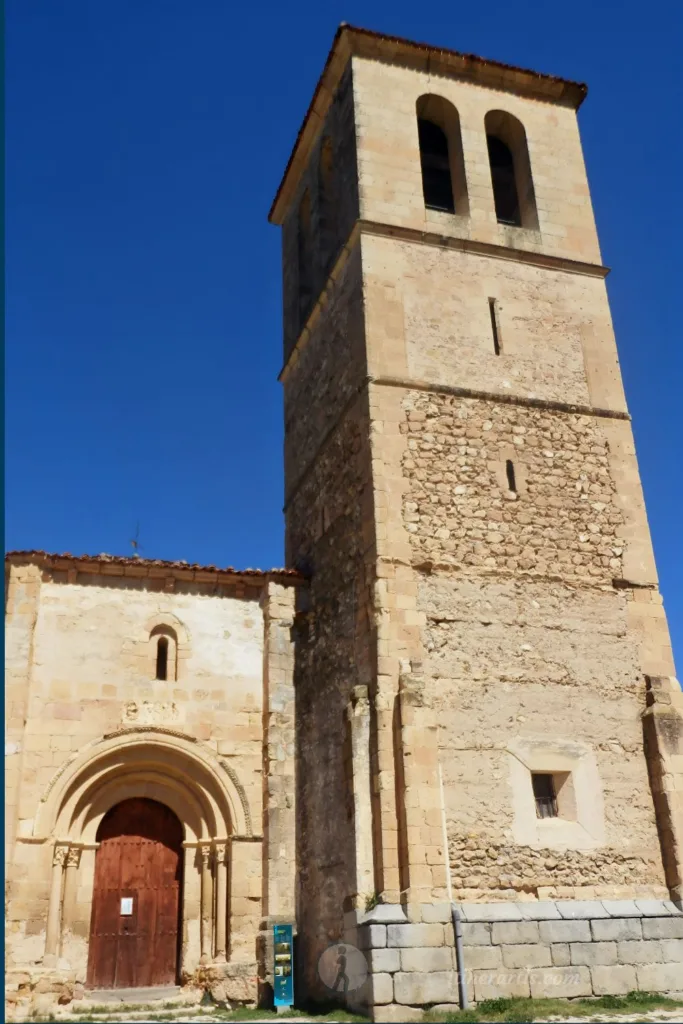
The interior of a mysterious temple
The Church of Vera Cruz features a central structure surrounded by a circular aisle divided into twelve sections with slightly pointed arches. These create a series of spaces covered by similarly pointed barrel vaults.
Once inside, you cannot help but notice the foundation plaque (engraved with the date of the church’s founding), translated as follows:
“May the founders of this temple be placed in the celestial seat, and may those who have strayed accompany them. Dedication of the church of the Holy Sepulcher on the Ides of April, in the era of 1246” (April 13, 1208).

The central Aedicula of the Church of Vera Cruz in Segovia
In the heart of the Church of Vera Cruz in Segovia, we find the Aedicula, a magnificent structure with an extraordinary history. This dodecagonal building stands tall in the center of the temple. It has two floors and protrudes to the outside, forming a roof lantern.
The first floor, with its open arches and four-ribbed vault, likely served penitential functions. Meanwhile, the second floor served as a place for knights to keep watch over their weapons before the battle. Today, the Knights of the Order of Malta hold their religious ceremonies here.
Visitors can ascend a double staircase with unique stones to reach the second floor and enter a small dodecagonal room with a double-ribbed vault. Here, they will find an altar decorated with interlocking horseshoe arches.
On the walls, one will find images of the patrons of the Order and a narrow wooden window that leads to two mysterious chambers. The purpose of these chambers remains a mystery to this day, puzzling history and architecture enthusiasts.
This 12-sided Aedicula is surrounded by a circular nave with a dodecagonal exterior. Three of its 12 sides house semi-dome apses, while a fourth shelters the tower. An additional apse is added later, with a small brick half-point arch window on the outside.
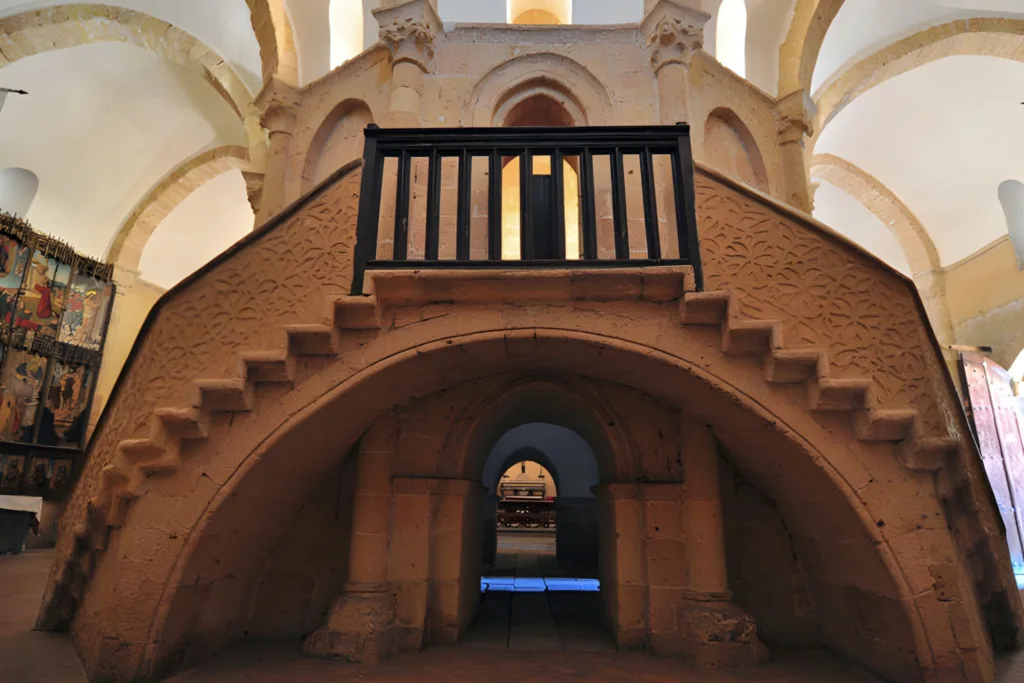
The apses of the Church of Vera Cruz in Segovia
The eastern-facing head of the temple showcases a majestic central apse and two lateral apses. These semicircular apses project from the main body of the church, adding depth and beauty to its architectural design.
The exterior walls are simple and smooth, with small half-point arch windows at the top of each side illuminating the temple. Sculpt moldings crown each side of the polygon, decorating the exterior walls.
This combination of a circular interior and semicircular apses creates a harmonious balance, imbuing the church with a sense of grace and tranquility.
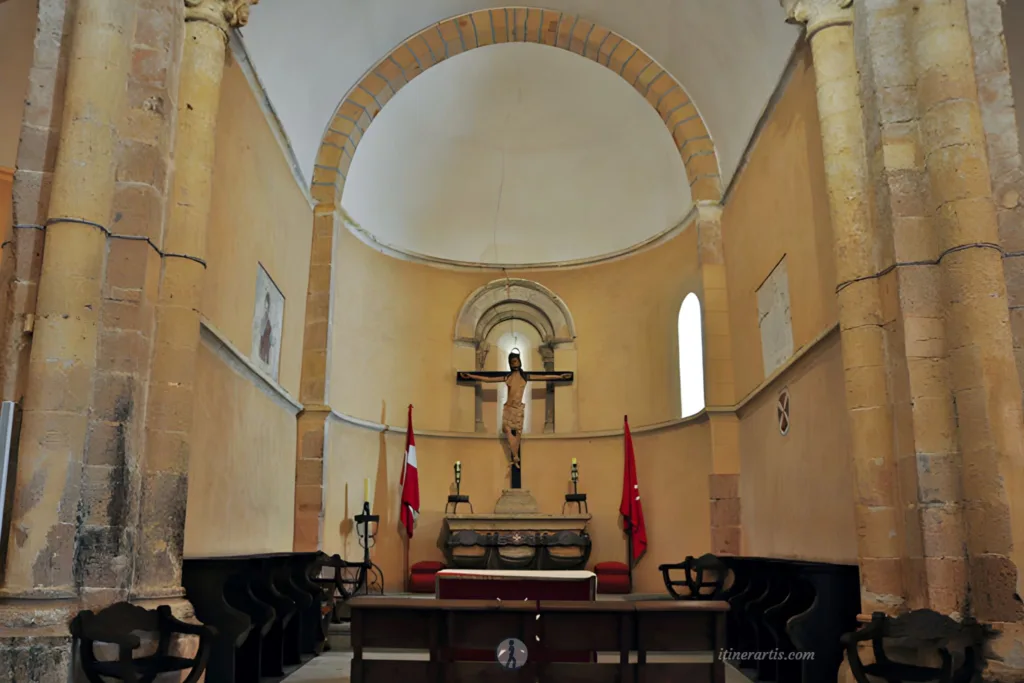
The Central apse
The central apse, more prominent than the side ones, presides over the entire temple. Inside it, we find an altar, and above it, a wooden sculpture of the crucified Christ. This artwork, dating from the 13th century, was purchased from an antique dealer in the mid-20th century.
In front of this main chapel, the floor holds sixteen funeral tiles from the late 17th century, belonging to residents of Zamarramala.
The Right apse
The apse of the Epistle will welcome visitors with a stunning altar displaying a Romanesque image of the Virgin of Peace, the church’s patroness since 1692.
Perched atop a small pedestal, shines the proud crest of the Order of Malta.
This beautiful sacred space also displays two 17th-century tombstones on the floor.
The Left apse
The Gospel Apse holds the Chapel of the Tabernacle, adorned with a replica of an image of Saint John the Baptist, patron of the Order of Malta.
On the left stands the brick doorway to the sacristy, built in the 15th century with a niche shape and a shell-shaped vault.
The Lignum Crucis Chapel of the Church of Vera Cruz in Segovia
The Lignum Crucis Chapel is a square-shaped structure located in the lower part of the Church of Vera Cruz tower. It is called the Lignum Crucis because it houses a piece of the cross of Christ that Pope Honorius III granted in 1216. The relic now rests in the Zamarramala parish church after facing repeated theft attempts.
.
The chapel’s 13th-century vault with four nerves, supported by corbels, offers a glimpse into the past. One wall still showcases fragments of 16th-century mural decoration, possibly depicting a tied Christ and Saint Christopher or, perhaps, a retinue of nobles carrying the holy cross.
However, the true highlight of the chapel is its Gothic limestone altarpiece, created in 1520 to house the Lignum Crucis relic. The central arch features an inscription reading “VICIT LEO DE TRIBV IVDA” (The lion of the tribe of Judah has overcome). A biblical reference to the triumph of David’s descendant, Christ, through the sacrifice symbolized by the Cross.
A conical arch and lateral pinnacles surrounds the inscription, while a string course with cardinals and angels holding the instruments of the Passion frames all of them.

Nestled beneath the altarpiece, an inverted mixed-line arch showcases two lions in full stride, clutching the shield of Don Gonzalo de Maldonado. Featuring a cross and five fleurs-de-lis, this work was commissioned by the penultimate commander of the Order of the Holy Sepulcher of Vera Cruz.
An inscription at medium height along the wall confirms this, reading:
“HOC OPUS PERFECTUM (EST) DE MANDATO DOMINI G. MALDONATHO ECCLESIA COMMENDATORIS. ANNO DOMINI MDXX,”
meaning
“This work was completed by mandate of the Lord G. de Maldonado, the Commander of this church, in the year of the Lord 1520”.
The artwork and imagery found within the Church of Vera Cruz in Segovia
Several notable pieces add to the beauty of the Church of Vera Cruz. Travelers can admire the intricate carvings and paintings depicting various religious themes and scenes, including representations of saints and Biblical figures.
These works of art provide a visual representation of the faith and devotion of those who built the church. Furthermore, they serve as a testament to the region’s rich cultural and artistic heritage.
The Altarpiece of the Resurrection, a masterwork in Church of Vera Cruz
The northern choir of the church houses the altarpiece of the Resurrection. The Factory of Santa Mara Magdalena created this Castilian school altarpiece in 1516, under the guidance of Commander Don Fray Juan Dávila. Restored in 1951 by the Fine Arts School of San Fernando, it now sits on a 15th-century pewter altar table.
The altarpiece comprises a bench and two bodies of five aisles, displaying scenes from the Life of Christ. The bench depicts eight apostles, distinguishable by their attributes: St. John the Evangelist holding the chalice, St. Andrew with the cross, St. Thomas with the architect’s square, and St. Peter with the keys on the Gospel side.
On the Epistle side, we see St. Paul with the sword, St. Bartholomew with the knife, St. James the Greater with the staff, shell, and pilgrim’s hat, and St. John the Baptist with the Agnus Dei.
The first body’s central aisle depicts the Resurrection, surrounded by scenes of the Crowning of Thorns, the ascent to Mount Calvary on the Gospel side, and the Three Marys at the empty tomb. The second body’s central aisle depicts St. John the Baptist with the Agnus Dei, and two praying figures on the Epistle side.
The second body features the Ascension, surrounded by scenes of Jesus and the Samaritan woman, the Pentecost, the Garden of Gethsemane, and the Flagellation.

Symbolism and Legends of the Church of Vera Cruz in Segovia
The Church of Vera Cruz strongly connects to the Templar Knights and links to the Holy Sepulcher in Jerusalem. Some would argue that the mere association of the building with the Knights Templar creates a disposition for legend.
The shape of the church links it to the number 12, of broad symbolism in the Judeo-Christian tradition. Moreover, it ties it to the Holy Sepulcher in Jerusalem and to the Dome of the Rock, the supposed Temple of Solomon in the Holy Land.
This connection to the Knights Templar and the Holy Sepulcher strengthens the church’s religious and historical importance. So, this well-knit symbolism has led to many popular stories and beliefs about the church. One popular belief is that it holds treasures of the knights buried in it.
The curse on the ravens
A further legend claims that a curse haunted the ravens after they attacked one of the knights who had died. People in Segovia say ravens cannot approach the church to this day.
Regardless of their truth, these legends only serve to add to the mystery and intrigue of this historical and religious landmark.

Celebrations and Rites in the Church of Vera Cruz in Segovia
The Church of Vera Cruz is not only an architectural and artistic wonder but also a site of religious and cultural significance. Nowadays, the Knights of Malta hold religious celebrations and rites within the church, including notable events such as the Cristo Yacente and the Lignum Crucis processions. During these celebrations, the Knights dress in black choir habits and process through the streets, enhancing the overall grandeur of the event.
Visiting the Church of Vera Cruz in Segovia
In conclusion, the Church of Vera Cruz in Segovia is a testament to the region’s rich cultural and religious heritage. Its unique dodecagonal architecture, stunning artwork, and powerful symbolism have captured the hearts and imaginations of visitors for centuries.
Its connection to the Knights Templar and the legends and celebrations that have taken place within its walls have only added to its mystique and allure. All in all, the Church of Vera Cruz stands as a testament to fate’s immense role in History, appearing as a mystery from another age for us to admire and enjoy.


